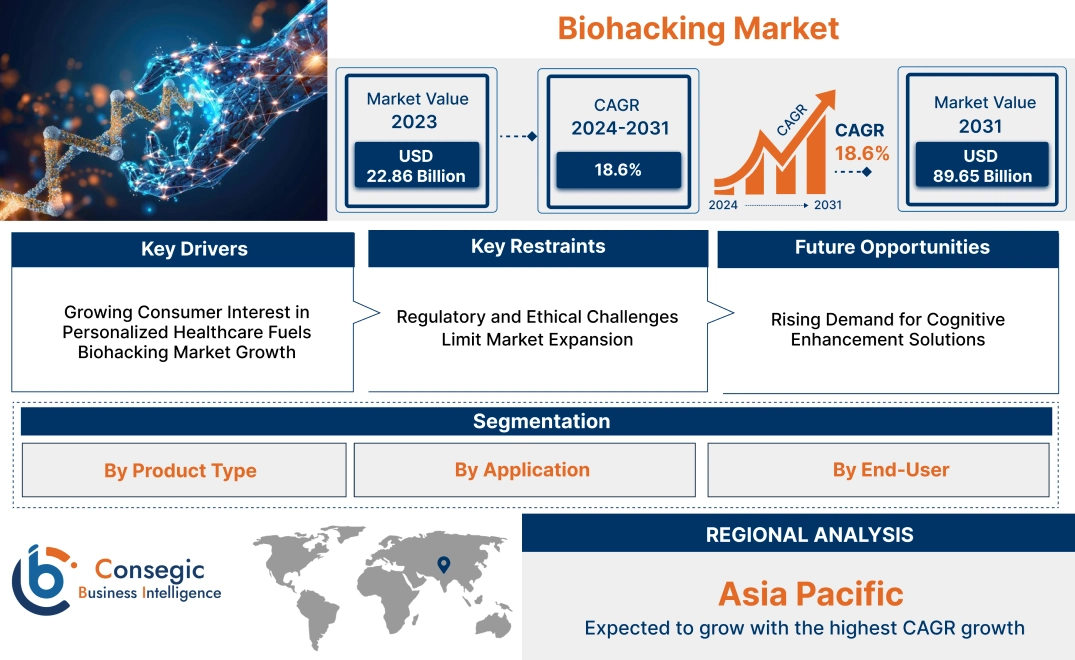- Summary
- Table Of Content
- Methodology
Biohacking Market Size:
Biohacking Market size is estimated to reach over USD 89.65 Billion by 2031 from a value of USD 22.86 Billion in 2023 and is projected to grow by USD 26.71 Billion in 2024, growing at a CAGR of 18.6% from 2024 to 2031.
Biohacking Market Scope & Overview:
Biohacking involves the practice of using science, technology, and self-experimentation to enhance physical and cognitive performance. This emerging market encompasses a wide range of products and services, including nootropics, wearable devices, genetic testing kits, and dietary supplements, aimed at optimizing body functions and well-being. Key characteristics include personalized health tracking, real-time data monitoring, and a focus on self-improvement through biology and technology. The benefits include enhanced mental clarity, improved physical health, and increased longevity. Applications span the healthcare, fitness, and wellness industries, with end-users including individual biohackers, fitness enthusiasts, healthcare professionals, and wellness centers.
Biohacking Market Dynamics - (DRO) :
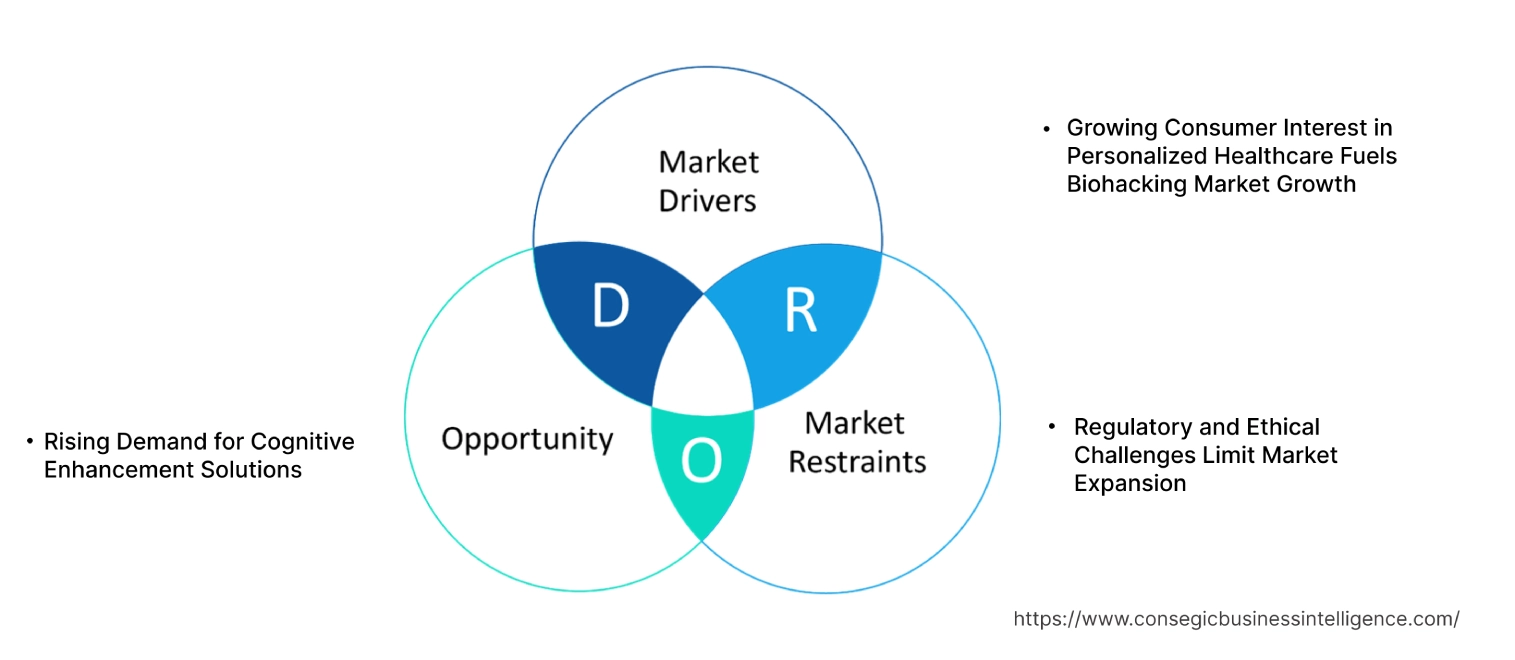
Key Drivers:
Growing Consumer Interest in Personalized Healthcare Fuels Biohacking Market Growth
The increasing consumer demand for personalized healthcare and wellness solutions is a primary driver of the market. Individuals are increasingly looking for tailored approaches to optimize their physical and mental health, leveraging data-driven insights and advanced self-monitoring tools. Biohacking practices, such as using nootropics, wearable devices, and genetic testing kits, allow users to track their health metrics, enhance cognitive functions, and optimize overall well-being. The rising popularity of wearable technology like continuous glucose monitors, sleep trackers, and smartwatches is empowering users to gain real-time insights into their biological data. This trend reflects a growing desire for self-optimization and proactive health management, driving the adoption of biohacking tools and techniques. As a result, according to the biohacking market analysis, it is experiencing robust growth, fueled by advancements in technology and increased awareness of self-improvement practices.
Key Restraints :
Regulatory and Ethical Challenges Limit Market Expansion
The market faces significant restraints due to regulatory uncertainties and ethical concerns surrounding the use of unapproved techniques and products. Many biohacking practices, such as genetic modifications and DIY biological experiments, often lack formal regulatory oversight, raising concerns about safety and potential health risks. The absence of standardized guidelines for evaluating the efficacy and safety of biohacking tools, including nootropics and supplements, limits consumer confidence and hampers widespread adoption. Additionally, ethical issues related to genetic editing, data privacy from wearable devices, and the potential misuse of these practices have led to increased scrutiny from regulatory bodies. These challenges create barriers for market players, hindering biohacking market growth and innovation.
Future Opportunities :
Rising Demand for Cognitive Enhancement Solutions
The increasing interest in cognitive enhancement and mental wellness presents a key biohacking market opportunity. With growing awareness about mental health and productivity optimization, consumers are seeking innovative solutions to boost cognitive performance. This trend is driving demand for nootropics, brain supplements, and neurostimulation devices aimed at improving focus, memory, and mental clarity. Advancements in neuroscience and biotechnology are enabling the development of new products designed to enhance brain function. As consumers become more aware of the benefits of biohacking for cognitive enhancement, market players have the opportunity to introduce tailored products and solutions, expanding their offerings and tapping into a rapidly growing consumer base.
Biohacking Market Segmental Analysis :
By Product Type:
The market is segmented based on product type into Wearables, Implants (Chips), Gene Modification Kits, Smart Drugs (Nootropics), Strains, and Others.
Wearables accounted for the largest revenue of 33.67% in 2023.
- Wearables, including fitness trackers, smartwatches, and biosensors, are the largest and most popular product segment in the market.
- These devices monitor physiological metrics like heart rate, sleep patterns, blood oxygen levels, and physical activity, providing real-time feedback for users seeking to optimize their health and fitness.
- The widespread adoption of wearables is driven by increasing health awareness, advancements in sensor technology, and integration with mobile applications.
- The demand for personalized health data and the trend towards preventive healthcare have further boosted this segment's growth.
- Therefore, the segment shows a rising trend in the adoption of healthcare optimization, technological advancement, and personalized treatment is propelling the market.
Implants (Chips) are expected to have the fastest CAGR during the forecasted period.
-
- Implants, including RFID (Radio Frequency Identification) chips and NFC (Near Field Communication) devices, are gaining traction as a core biohacking tool.
- These subdermal implants enable users to perform tasks like unlocking doors, accessing secure digital devices, or even storing health data.
- The growing interest in body augmentation and human enhancement drives the popularity of these devices, appealing to early adopters and tech enthusiasts.
- The implantable technology market is evolving with innovations that offer new capabilities, including biosensors that monitor blood glucose levels or microchips designed for tracking and identification purposes.
- Hence, the segmental analysis shows rising trends due to the adoption of new tools and devices, resulting in a significant rise in the biohacking market opportunities.
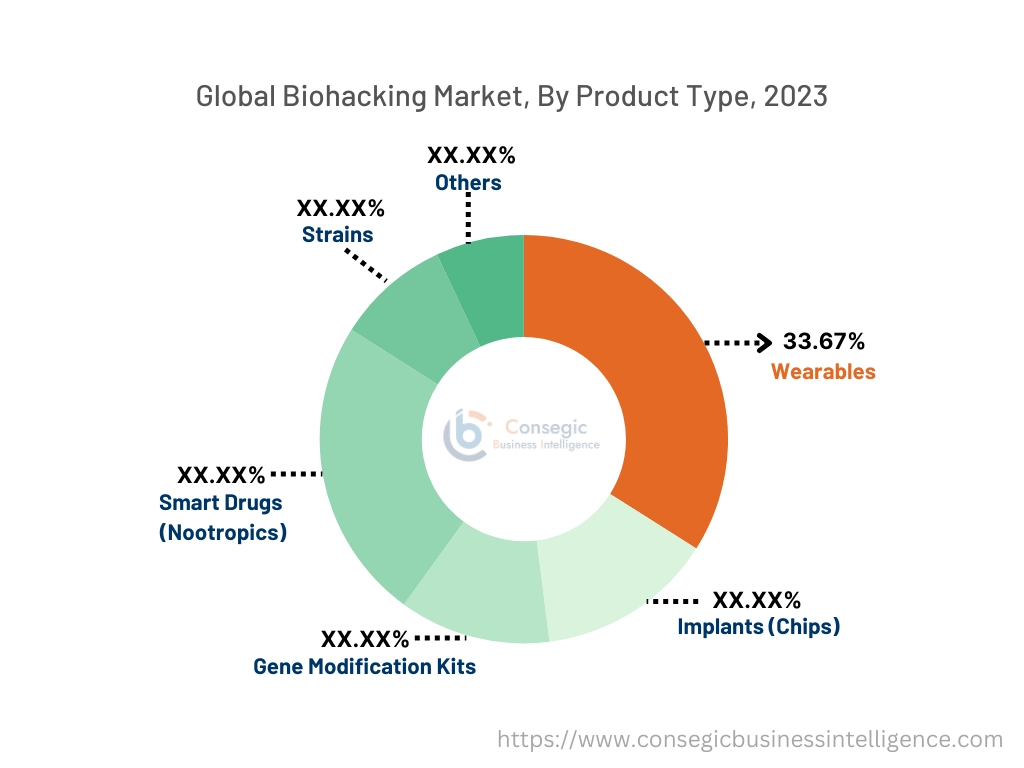
By Application:
The market is segmented based on application type into Synthetic Biology, Genetic Engineering, Forensic Science, Diagnosis & Treatment, and Drug Testing.
Synthetic Biology accounted for the largest revenue share of the total biohacking market share in 2023.
- Synthetic biology is a leading application within the market, involving the design and creation of new biological parts, devices, and systems.
- Biohackers use synthetic biology techniques to engineer microorganisms, create custom DNA sequences, and develop new biosynthetic pathways.
- This application is widely utilized in developing innovative therapies, environmental solutions, and biological manufacturing processes.
- The convergence of synthetic biology with biohacking practices has expanded possibilities in personalized medicine, enabling users to manipulate biological systems at a molecular level, thus contributing to significant advancements in healthcare and biotechnology.
- Therefore, the analysis depicts the rising trends in the adoption of innovative therapies, and personalized medicines resulting in the rising biohacking market demand.
Genetic Engineering is expected to have the fastest CAGR during the forecasted period.
- Genetic engineering, a central application in the market, focuses on the direct manipulation of an organism's DNA using biotechnological tools.
- Techniques like CRISPR (Clustered Regularly Interspaced Short Palindromic Repeats) have become accessible to biohackers, allowing them to experiment with gene editing to enhance physical capabilities, alter genetic traits, or conduct personal research.
- The rise of DIY (Do-It-Yourself) gene modification kits has fueled interest in genetic engineering, empowering individuals to explore genetic enhancements outside traditional laboratory settings.
- Hence, the segmental analysis portrays that the adoption of biotechnology tools, or DIY kits, boosts the biohacking market trends.
By End-User:
The market is segmented based on end-users into Pharmaceutical & Biotechnology Companies, Hospitals & Clinics, Forensic Laboratories, and Research & Academic Institutes.
Pharmaceutical & Biotechnology Companies accounted for the largest revenue in the biohacking market share in 2023.
- Pharmaceutical and biotechnology companies are major end users of biohacking technologies, integrating these innovations into drug discovery, development, and testing processes.
- These companies utilize biohacking tools like wearable sensors and genetic engineering kits to enhance research capabilities, streamline clinical trials, and gather real-time patient data.
- The adoption of biohacking practices helps accelerate R&D efforts, improving the accuracy of drug efficacy assessments, and reducing costs associated with traditional research methods.
- This segment is driven by the increasing focus on personalized medicine and the need for precise, data-driven approaches in drug development.
- Hence, according to the segmental analysis the adoption of innovative drugs and drug assessments is anticipating a rise in biohacking market trends.
Research & Academic Institutes is expected to have the fastest CAGR during the forecasted period.
- Research and academic institutes represent a significant user segment in the market, employing advanced biohacking tools and techniques for scientific studies and educational purposes.
- Universities and research centers use wearable devices, genetic modification kits, and synthetic biology tools to conduct experiments, study human physiology, and explore new therapeutic avenues.
- The emphasis on innovative research in fields like genomics, neuroscience, and synthetic biology has led to increased adoption of biohacking practices.
- This segment is fueled by growing investments in research and the expanding curriculum in biohacking and biotechnology across academic programs.
- Hence, the biohacking market analysis concludes that the rising trends due to the adoption of biotechnology and biohacking practices are proliferating the market.
Regional Analysis:
The regions covered are North America, Europe, Asia Pacific, the Middle East and Africa, and Latin America.
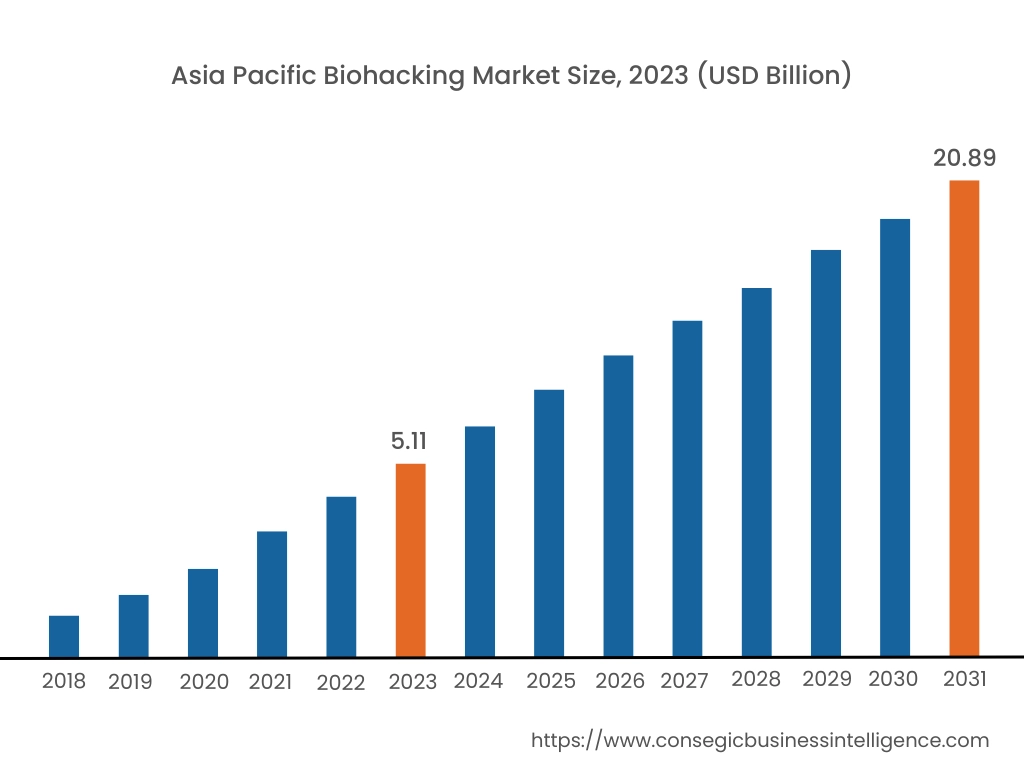
Asia Pacific region was valued at USD 5.11 Billion in 2023. Moreover, it is projected to grow by USD 5.99 Billion in 2024 and reach over USD 20.89 Billion by 2031. Out of these, China accounted for the largest share of 33.8% in 2023. The Asia-Pacific region is experiencing rapid growth in the market, with countries such as China, India, and Japan investing heavily in biotechnology and healthcare innovations. The increasing prevalence of chronic diseases and a rising middle class with disposable income are key factors driving biohacking market expansion. Technological advancements and government initiatives further support the adoption of biohacking practices.
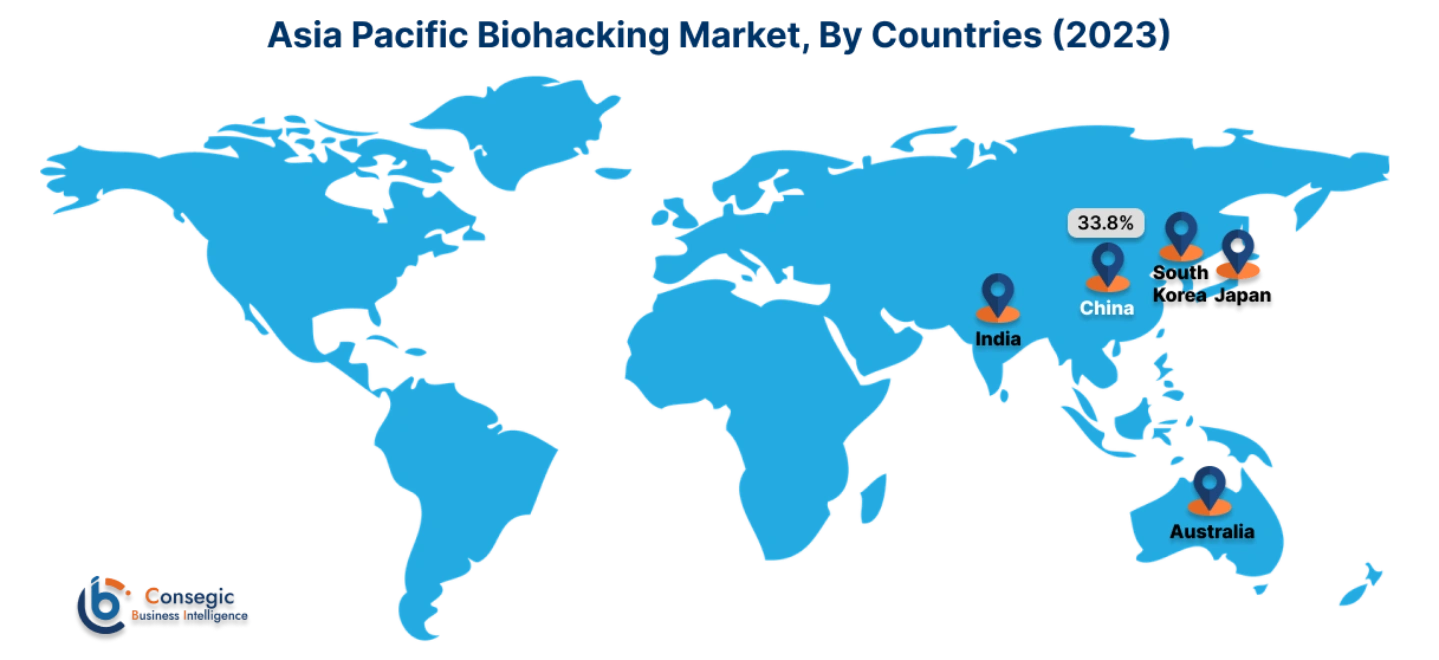
North America is estimated to reach over USD 37.93 Billion by 2031 from a value of USD 9.61 Billion in 2023 and is projected to grow by USD 11.24 Billion in 2024. This dominance is attributed to the region's advanced healthcare infrastructure, high adoption rates of wearable technologies, and significant investments in research and development. The presence of numerous technology companies and research institutions fosters innovation in products and services.
Europe holds a substantial share of the market, driven by stringent healthcare regulations and a strong emphasis on personalized medicine. Countries like Germany and the UK are at the forefront, with active biohacking communities and government support for research initiatives. The region's focus on preventive healthcare and wellness contributes to the growing trends of biohacking market demand.
In the Middle East and Africa, the market is emerging, influenced by growing healthcare awareness and investments in medical technologies. Countries like the UAE and Saudi Arabia are leading the way, with initiatives aimed at enhancing healthcare services and promoting wellness. However, the market faces challenges due to regulatory constraints and limited access to advanced products.
Latin America is witnessing gradual growth in the market, driven by increasing healthcare needs and a focus on preventive care. Brazil and Mexico are the primary contributors, with rising awareness of biohacking benefits and a growing interest in personalized health solutions. The market is supported by collaborations between local startups and international companies aiming to introduce innovative biohacking products to the region.
Top Key Players & Market Share Insights:
The biohacking market is highly competitive with major players providing products and services to the national and international markets. Key players are adopting several strategies in research and development (R&D), product innovation, and end-user launches to hold a strong position in the global biohacking market. Key players in the biohacking industry include –
- Apple Inc. (United States)
- Fitbit, Inc. (United States)
- HVMN Inc. (United States)
- The ODIN (United States)
- Thync Global Inc. (United States)
- Moodmetric (Finland)
- Muse (Interaxon Inc.) (Canada)
- TrackMyStack (United States)
- OsteoStrong (United States)
- Synbiota (Canada)
Recent Industry Developments :
Product Launche:
In June 2024, Thync Global unveiled two innovative neurostimulation devices: Thync Calm+, a wearable device designed to alleviate stress and anxiety using low-energy neurosignals, and Thync Relax Pro, an enhanced version of their neurostimulation technology aimed at improving sleep quality through transdermal neuromodulation. These advancements highlight Thync Global's commitment to integrating neuroscience with wearable technology to promote overall well-being.
Biohacking Market Report Insights :
| Report Attributes | Report Details |
| Study Timeline | 2018-2031 |
| Market Size in 2031 | USD 89.65 Billion |
| CAGR (2024-2031) | 18.6% |
| By Product Type |
|
| By Application |
|
| By End-user |
|
| By Region |
|
| Key Players |
|
| North America | U.S. Canada Mexico |
| Europe | U.K. Germany France Spain Italy Russia Benelux Rest of Europe |
| APAC | China South Korea Japan India Australia ASEAN Rest of Asia-Pacific |
| Middle East and Africa | GCC Turkey South Africa Rest of MEA |
| LATAM | Brazil Argentina Chile Rest of LATAM |
| Report Coverage |
|
Key Questions Answered in the Report
What is the current size of the biohacking market? +
The biohacking market is rapidly expanding, estimated at around USD 22.86 billion in 2023, with projections to surpass USD 89.65 billion by 2031.
What factors are driving the biohacking market growth? +
Growing interest in self-optimization, advancements in wearable technology, and the increasing trend of personalized healthcare are key growth drivers.
What challenges are limiting the growth of the biohacking market? +
High costs, ethical concerns, and regulatory hurdles, especially related to genetic modifications and data privacy, are key market constraints.
How is wearable technology influencing the biohacking market? +
Wearables like smartwatches and health trackers are revolutionizing biohacking by enabling real-time monitoring of vital signs and fitness metrics.
Why is personalized medicine a significant trend in the biohacking market? +
Personalized medicine aligns with biohacking principles, focusing on tailored treatments and individual health optimization based on genetic data.
